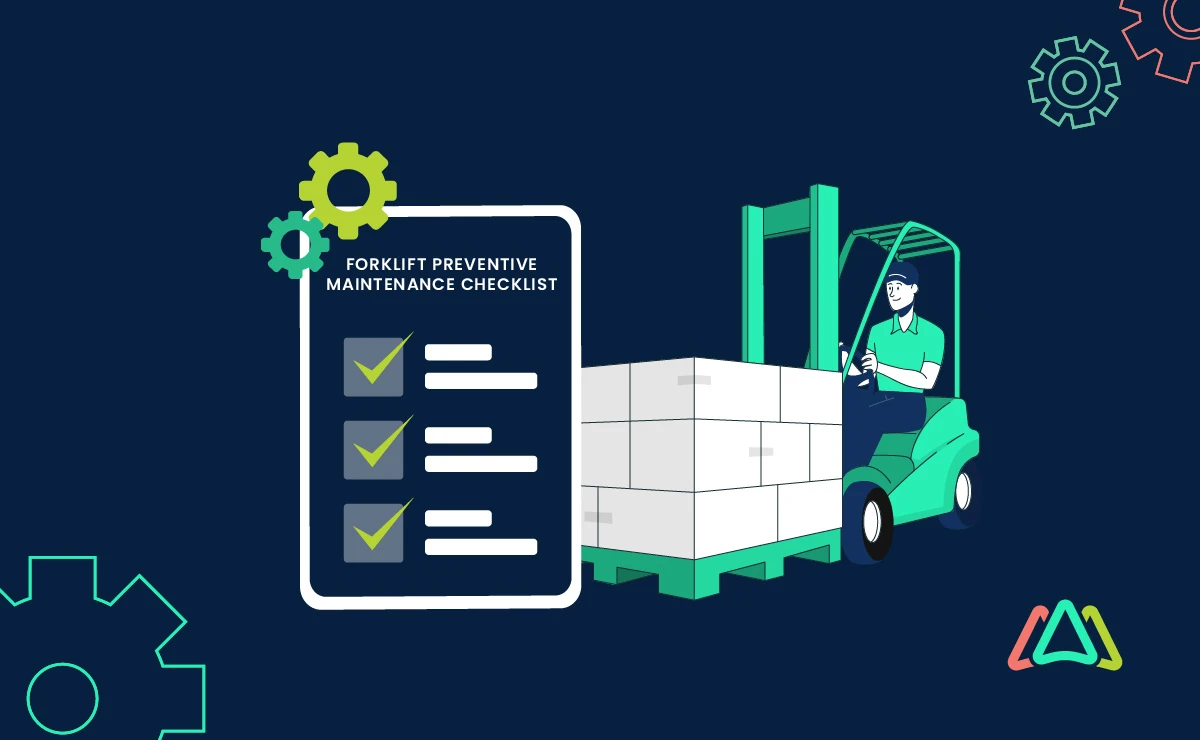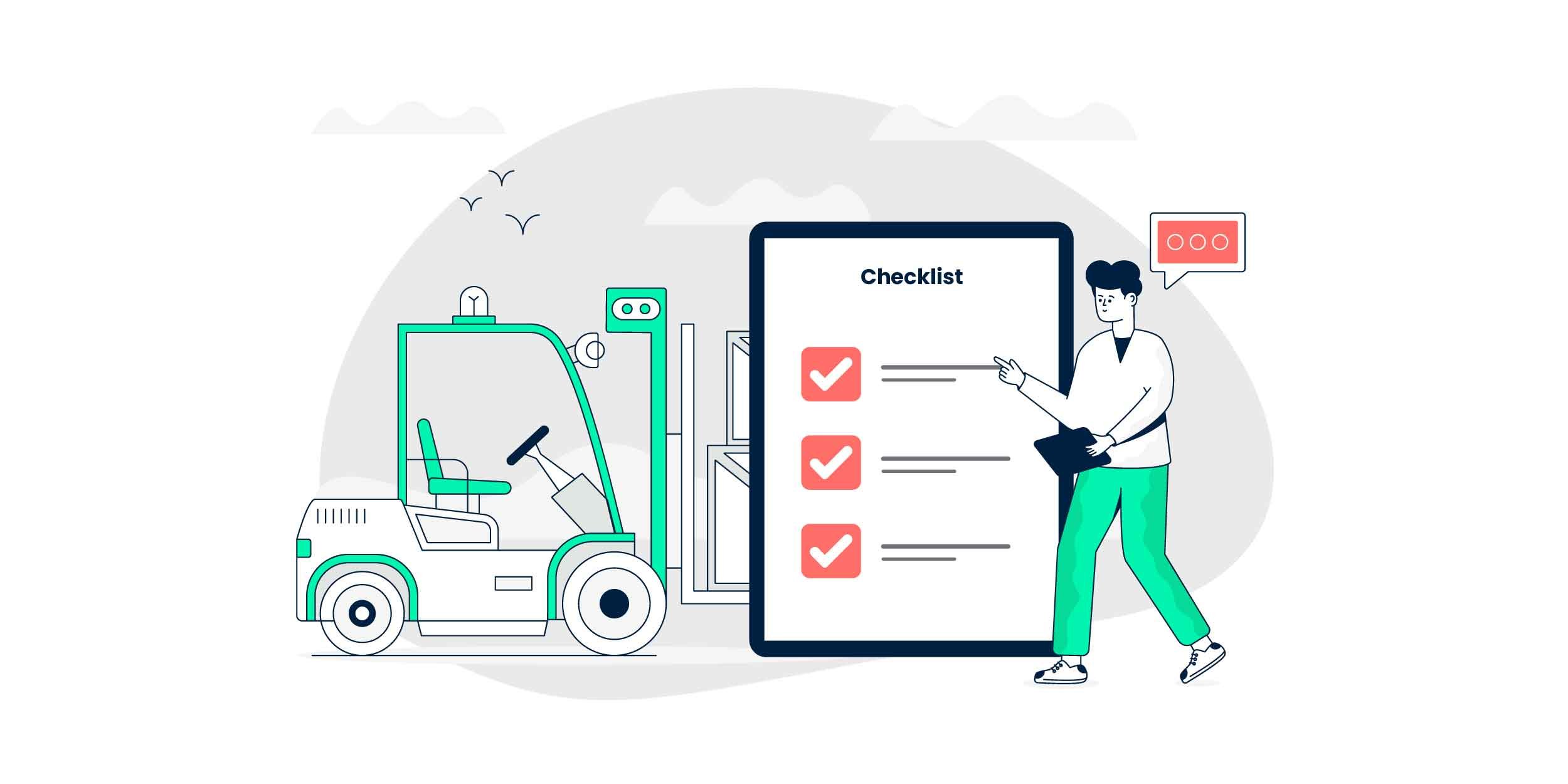
Forklift Preventive Maintenance Checklist
Forklifts play a critical role in warehouse operations, construction sites, manufacturing facilities, and logistics centers, among others. Regular maintenance is essential to keep forklifts operating at peak performance levels and prevent costly breakdowns or accidents. Here are some key reasons why forklift maintenance is vital:
- Safety: Properly maintained forklifts are safer to operate, reducing the risk of accidents and injuries to operators, pedestrians, and other workers in the vicinity.
- Reliability: Scheduled maintenance helps identify and address potential issues before they escalate, ensuring that forklifts remain reliable and operational when needed.
- Efficiency: Well-maintained forklifts operate more efficiently, leading to increased productivity, faster material handling, and smoother workflow processes.
- Cost Savings: Preventive maintenance helps avoid expensive repairs and downtime associated with unexpected breakdowns, saving money on repair costs, replacement parts, and lost productivity.
- Compliance: Regular maintenance ensures that forklifts comply with safety regulations and industry standards, reducing the risk of penalties, fines, or legal liabilities.
A forklift maintenance checklist is a comprehensive tool used by maintenance technicians to systematically inspect, lubricate, and service forklifts according to manufacturer recommendations and industry best practices. This checklist typically covers various components and systems of the forklift, including:
- Engine and drivetrain
- Hydraulic system
- Steering and brakes
- Electrical components
- Tires and wheels
- Forks and attachments
- Safety features and controls
By following the forklift maintenance checklist on a regular basis, organizations can identify potential issues early, address them promptly, and keep their forklifts in optimal working condition. This not only ensures the safety of operators and workers but also maximizes the efficiency, reliability, and longevity of these essential pieces of equipment, as part of a wider industrial preventive maintenance checklist.
Pre-Operation Checks
Before operating a forklift, it's essential to conduct thorough pre-operation checks to ensure that the equipment is in safe and proper working condition.

1. Visual Inspection
- Tires: Inspect the tires for signs of wear, damage, or improper inflation. Ensure that the tire treads are in good condition and free from any cuts or punctures that could affect traction and stability.
- Fluid Levels: Check the fluid levels, including engine oil, hydraulic fluid, coolant, and brake fluid. Top up any fluids that are low to prevent mechanical issues or overheating during operation.
- Leaks: Look for any visible leaks or drips under the forklift, including hydraulic fluid, engine oil, or coolant leaks. Address any leaks promptly to prevent fluid loss and potential equipment damage.
- Cables and Hoses: Inspect the cables and hoses for signs of wear, damage, or leaks. Ensure that all connections are secure and free from any corrosion or fraying that could compromise the integrity of the hydraulic or electrical systems.
2. Functional Inspection

- Lights: Test all lights, including headlights, taillights, turn signals, and brake lights, to ensure that they are functioning properly. Proper lighting is essential for visibility and safety, especially when operating the forklift in low-light conditions or indoor environments.
- Horn: Test the horn to ensure that it is loud and audible. The horn is an important safety feature that alerts pedestrians and other workers to the presence of the forklift, especially in noisy or busy work areas.
- Steering: Check the steering system for smooth and responsive operation. Turn the steering wheel from lock to lock to ensure that there is no binding, excessive play, or abnormal resistance, which could indicate a problem with the steering mechanism.
- Brakes: Test the brakes to ensure that they are functioning properly and provide adequate stopping power. Engage the parking brake and test the service brakes by gently applying pressure to the brake pedal. Listen for any unusual noises or vibrations and ensure that the forklift comes to a smooth and controlled stop.
By performing these pre-operation checks diligently and regularly, operators can identify potential issues early and take corrective action to ensure the safe and reliable operation of the forklift. This not only protects the operator and other workers but also helps prevent accidents, injuries, and equipment damage in the workplace.
Operational Checks
Once the pre-operation checks have been completed and the forklift is ready to be used, it's essential to perform operational checks to ensure that all systems are functioning correctly during operation.
A. Battery
- Charge Level: Check the battery charge level to ensure that it has sufficient power for the intended operation. A fully charged battery is essential for optimal performance and prevents unexpected shutdowns during operation.
- Water Levels (if applicable): If the forklift is equipped with a lead-acid battery, check the water levels in each cell regularly. Ensure that the water level is above the plates but below the maximum fill line to prevent overfilling. Add distilled water as needed to maintain the proper water level.
B. Hydraulic System
- Fluid Levels: Inspect the hydraulic fluid levels in the reservoir to ensure that they are within the recommended range. Low hydraulic fluid levels can lead to decreased performance and potential damage to hydraulic components.
- Hydraulic Leaks: Check for any visible signs of hydraulic leaks, such as puddles or drips under the forklift. Inspect hydraulic hoses, fittings, and connections for signs of wear, damage, or loose connections. Address any leaks promptly to prevent fluid loss and maintain hydraulic system integrity.
C. Cooling System
- Radiator: Inspect the radiator and cooling fins for any signs of damage, debris buildup, or blockages that could restrict airflow and affect cooling efficiency. Clean the radiator and cooling fins as needed to ensure proper heat dissipation.
- Coolant Levels: Check the coolant levels in the radiator or coolant reservoir to ensure that they are at the proper level. Low coolant levels can lead to overheating and engine damage. Top up the coolant as needed with the appropriate coolant mixture recommended by the manufacturer.
By performing these operational checks before and during forklift operation, operators can ensure that the forklift's essential systems are functioning correctly and prevent potential issues that could lead to downtime or equipment damage. Regular maintenance and monitoring of these systems are essential for safe and efficient forklift operation in various work environments.
Post-Operation Checks
After completing forklift operations, it's important to conduct post-operation checks to ensure that the equipment is properly maintained and prepared for the next use.
1. Cleanliness
- Exterior: Inspect the exterior of the forklift for any dirt, debris, or spills accumulated during operation. Use a brush or compressed air to remove any debris from the chassis, wheels, and other external components.
- Operator Cabin: Clean the operator cabin, including the seat, controls, and floor area. Remove any trash, debris, or spilled materials to maintain a clean and comfortable working environment for the operator.
2. Battery Maintenance (if applicable)
- Cooling: Allow the battery to cool down after extended use before performing any maintenance tasks. High operating temperatures can affect battery performance and longevity.
- Water Levels: If the forklift is equipped with a lead-acid battery, check the water levels in each cell after operation. Ensure that the water level is within the recommended range and add distilled water if necessary to maintain proper levels.
- Charging: If the battery needs recharging, follow the manufacturer's recommendations for charging procedures and safety precautions. Avoid overcharging the battery, as it can lead to reduced battery life and performance.
3. Fluid Top-Up
- Hydraulic Fluid: Check the hydraulic fluid levels in the reservoir after operation. Top up the fluid as needed to maintain optimal levels for smooth and efficient hydraulic system operation.
- Coolant: Inspect the coolant levels in the radiator or coolant reservoir. Top up the coolant as needed with the appropriate coolant mixture to prevent overheating and maintain engine performance.
4. Storage Procedures

- Parking: Park the forklift in a designated parking area away from pedestrian traffic and other equipment. Engage the parking brake and lower the forks to the ground to secure the forklift in place.
- Shutdown: Turn off the engine and remove the key from the ignition. Ensure that all controls are in the neutral position and any attachments or accessories are properly secured.
- Cover: If the forklift will be stored outdoors or in a dusty environment, consider covering it with a tarp or protective cover to prevent dirt, debris, and moisture from accumulating on the surfaces.
By performing these post-operation checks and maintenance tasks, operators can ensure that the forklift remains in good working condition and ready for the next operation. Regular maintenance and care contribute to the longevity, reliability, and safety of the forklift, ultimately maximizing its performance and value to the organization.
Regular Maintenance Schedule
Establishing a regular maintenance schedule is essential for ensuring the ongoing performance, reliability, and safety of forklifts.
1. Daily Checks
- Visual Inspection: Conduct a visual inspection of the forklift before each use to check for any visible signs of damage, leaks, or wear. Pay attention to tires, hydraulic hoses, and other critical components.
- Fluid Levels: Check fluid levels, including engine oil, hydraulic fluid, coolant, and brake fluid, daily. Top up any fluids that are low to ensure proper lubrication and cooling of essential components.
- Battery: If the forklift is equipped with a battery, check the battery charge level and water levels daily. Ensure that the battery is adequately charged and properly maintained for optimal performance.
2. Weekly Checks
- Tire Pressure: Check tire pressure weekly and adjust as needed to ensure proper inflation. Proper tire pressure is essential for traction, stability, and overall forklift performance.
- Brake Inspection: Test the brakes weekly to ensure that they are functioning correctly and provide adequate stopping power. Listen for any unusual noises or vibrations and address any issues promptly.
- Lights and Horn: Test all lights, including headlights, taillights, turn signals, and brake lights, weekly to ensure that they are functioning properly. Test the horn to ensure that it is loud and audible.
3. Monthly Checks
- Engine Air Filter: Inspect the engine air filter monthly and clean or replace it as needed. A clean air filter is essential for maintaining engine performance and fuel efficiency.
- Hydraulic System: Check the hydraulic system for leaks and inspect hydraulic hoses, fittings, and connections for signs of wear or damage. Address any issues promptly to prevent hydraulic system failure.
- Cooling System: Inspect the radiator, cooling fins, and coolant levels monthly to ensure proper cooling system operation. Clean the radiator and cooling fins as needed to prevent overheating.
4. Quarterly Checks
- Steering and Suspension: Inspect the steering system, including tie rods, ball joints, and steering linkage, quarterly to ensure proper operation. Check the suspension components for wear or damage.
- Exhaust System: Check the exhaust system for leaks, rust, or damage quarterly. Ensure that the exhaust system is properly secured and free from any obstructions that could affect engine performance.
- Attachments and Forks: Inspect forklift attachments and forks quarterly for signs of wear, damage, or misalignment. Ensure that attachments are properly secured and functioning correctly for safe material handling operations.
By following a regular maintenance schedule and performing these checks diligently, operators can identify potential issues early, address them promptly, and keep their forklifts in optimal working condition. This proactive approach to maintenance not only ensures the safety of operators and other workers but also maximizes the efficiency, reliability, and longevity of the forklifts, ultimately reducing downtime and maintenance costs for the organization.
Importance of Documentation
Documentation plays an important role in forklift maintenance, providing a comprehensive record of maintenance activities, inspections, and repairs.
1. Record-Keeping
- Maintenance History: Proper documentation allows maintenance personnel to maintain a detailed history of all maintenance activities performed on each forklift. This includes information such as inspection dates, repair records, parts replacements, and service intervals. A complete maintenance history provides valuable insights into the forklift's condition, performance, and reliability over time.
- Service Records: Documentation helps track service schedules and intervals for routine maintenance tasks, such as oil changes, filter replacements, and fluid inspections. By recording service dates and mileage/hours, maintenance teams can ensure that forklifts receive timely servicing to prevent breakdowns and extend their lifespan.
2. Compliance with Regulations
- Regulatory Requirements: Forklift maintenance is subject to various regulations and standards, including those set forth by organizations such as OSHA (Occupational Safety and Health Administration) and ANSI (American National Standards Institute). Proper documentation ensures compliance with these regulations by providing evidence of regular inspections, maintenance activities, and safety checks.
- Audit Trails: Documentation serves as an audit trail for regulatory inspections and internal audits. Having accurate and up-to-date maintenance records readily available facilitates compliance verification and demonstrates the organization's commitment to safety and regulatory compliance.
3. Identification of Patterns and Trends
- Performance Analysis: Maintenance documentation allows organizations to analyze forklift performance trends over time. By tracking maintenance metrics such as downtime, repair frequency, and component failures, maintenance managers can identify patterns and trends that may indicate underlying issues or areas for improvement.
- Predictive Maintenance: Analyzing maintenance data enables the implementation of predictive maintenance strategies, where maintenance activities are scheduled based on equipment condition and performance rather than fixed intervals. Predictive maintenance helps minimize downtime, reduce maintenance costs, and optimize asset performance by addressing issues proactively before they escalate.
Safety Considerations
1. Training for Operators
- Initial Training: All forklift operators should undergo comprehensive training before operating the equipment. Training programs should cover topics such as forklift operation, safety procedures, load handling, and emergency protocols. Operators should receive hands-on training and demonstrate competency in operating the forklift safely before being allowed to operate independently.
- Refresher Training: Regular refresher training sessions should be conducted to reinforce safe operating practices and update operators on any changes in procedures or regulations. Refresher training helps ensure that operators maintain proficiency in forklift operation and stay informed about the latest safety guidelines.
- Specialized Training: Operators should receive specialized training for specific tasks or environments, such as operating forklifts in hazardous locations, handling hazardous materials, or using specialized attachments. Specialized training ensures that operators are equipped with the knowledge and skills necessary to perform their duties safely and effectively in various situations.
2. Reporting Procedures for Defects
- Routine Inspections: Operators should conduct pre-operation inspections of the forklift to identify any defects, malfunctions, or safety hazards. Any issues discovered during routine inspections should be reported to maintenance personnel immediately for evaluation and repair.
- Formal Reporting: Establish formal procedures for reporting defects or safety concerns discovered during operation. Operators should have a clear understanding of how and where to report issues, whether through a written report, electronic system, or direct communication with supervisors or maintenance personnel.
- Timely Resolution: Defects and safety concerns should be addressed promptly to prevent accidents, injuries, or equipment damage. Maintenance personnel should prioritize and expedite repairs for reported issues to minimize downtime and maintain the safety and reliability of the forklift fleet.
3. Emergency Protocols
- Emergency Stop Procedures: Operators should be trained on emergency stop procedures in case of an emergency or equipment malfunction. They should know how to quickly and safely stop the forklift and secure the area to prevent accidents or injuries.
- Evacuation Procedures: Establish evacuation procedures in case of emergencies such as fires, chemical spills, or structural collapses. Operators should know the designated evacuation routes, assembly areas, and emergency contact information to ensure a swift and orderly evacuation if necessary.
- Communication Protocols: Implement clear communication protocols for emergencies to ensure that all personnel are informed and aware of the situation. Use alarm systems, verbal announcements, or visual signals to communicate emergency alerts and instructions effectively.
Benefits of Proactive Maintenance
Implementing proactive maintenance practices offers numerous advantages for forklift fleets, contributing to their longevity, efficiency, and safety.
1. Extended Lifespan of Forklift
- Preventive Repairs: Proactive maintenance allows for the early detection and correction of potential issues before they escalate into major problems. By addressing minor issues promptly, such as fluid leaks, worn components, or calibration errors, forklifts can operate more reliably and experience fewer breakdowns over time.
- Optimized Performance: Regular maintenance tasks, such as lubrication, adjustments, and component replacements, help ensure that forklifts operate at peak performance levels. By maintaining optimal operating conditions, forklift components experience less wear and tear, leading to a longer lifespan for the equipment.
2. Reduced Downtime
- Scheduled Maintenance: Proactive maintenance involves scheduling routine inspections, servicing, and repairs during planned downtime periods. By proactively addressing maintenance needs, organizations can minimize unplanned downtime caused by unexpected breakdowns or equipment failures, maximizing operational efficiency and productivity.
- Predictive Maintenance: Utilizing predictive maintenance techniques, such as condition monitoring and predictive analytics, allows organizations to anticipate and address maintenance needs before they result in downtime. By monitoring equipment health indicators and performance metrics, maintenance can be scheduled based on actual equipment condition rather than arbitrary time intervals.
3. Enhanced Safety
- Reliable Equipment: Proactive maintenance helps ensure that forklifts are in safe and reliable operating condition at all times. By addressing potential safety hazards, such as faulty brakes, worn tires, or malfunctioning safety features, organizations can reduce the risk of accidents, injuries, and property damage in the workplace.
- Compliance with Regulations: Regular maintenance helps organizations comply with safety regulations and industry standards governing forklift operation and maintenance. By maintaining accurate maintenance records and conducting inspections as required, organizations demonstrate their commitment to safety and regulatory compliance.
4. Cost Savings
- Preventive Cost Management: Proactive maintenance helps organizations manage maintenance costs more effectively by avoiding costly repairs and unexpected downtime. By investing in preventive maintenance, organizations can reduce the need for emergency repairs, replacement parts, and overtime labor, resulting in long-term cost savings.
- Asset Preservation: Regular maintenance preserves the value and condition of forklift assets over time, reducing the need for premature replacement or major overhauls. By extending the lifespan of forklifts through proactive maintenance, organizations can maximize the return on their investment and minimize total cost of ownership.
Leverage a CMMS to Manage the Forklift Preventive Maintenance Checklist
Using a Computerized Maintenance Management System (CMMS) for forklift preventive maintenance can streamline maintenance processes, enhance efficiency, and ensure the longevity and reliability of forklift fleets.
1. Centralized Maintenance Management
A CMMS serves as a centralized platform for managing all maintenance-related activities, including forklift preventive maintenance. Organizations can create, schedule, and track maintenance tasks for their entire forklift fleet within the CMMS, providing a single source of truth for maintenance operations.
2. Automated Task Scheduling
One of the key benefits of a CMMS software is its ability to automate task scheduling based on predefined criteria. Organizations can create preventive maintenance schedules for each forklift in their fleet, specifying the frequency of maintenance tasks such as inspections, lubrication, and component replacements. The CMMS will automatically generate work orders and assign tasks to maintenance technicians according to the predetermined schedule.
3. Customizable Checklist Templates
A CMMS allows organizations to create customizable checklist templates for forklift preventive maintenance tasks. These templates can include a comprehensive list of inspection items, lubrication points, and maintenance procedures specific to each forklift model and manufacturer. Maintenance technicians can easily access and complete these checklists using mobile devices or tablets while performing maintenance activities.
4. Equipment History Tracking
With a CMMS, organizations can track the maintenance history of each forklift in their fleet, including all completed maintenance tasks, inspections, and repairs. This historical data provides valuable insights into the performance and condition of each forklift over time, helping organizations identify trends, predict potential issues, and make data-driven maintenance decisions.
5. Real-Time Monitoring and Alerts
CMMS systems often include real-time monitoring capabilities that allow organizations to track key performance metrics and receive alerts for maintenance events or abnormalities. Maintenance managers can set up alerts for upcoming preventive maintenance tasks, overdue inspections, or equipment malfunctions, ensuring timely action and minimizing downtime.
6. Parts and Inventory Management
A CMMS can also facilitate parts and inventory management for forklift maintenance activities. Organizations can track spare parts, consumables, and lubricants within the CMMS, ensuring that maintenance technicians have the necessary materials on hand when performing preventive maintenance tasks. This helps streamline the maintenance process and minimize delays due to missing parts or supplies.
With automated task scheduling, customizable checklist templates, equipment history tracking, real-time monitoring, and parts management capabilities, CMMS systems provide a comprehensive solution for managing and maintaining forklift fleets effectively.
TABLE OF CONTENTS
Keep Reading
Spare parts management within maintenance can make the difference between a problem-free ...
16 Dec 2025
Every maintenance team eventually faces the same question: When should we repair, and when ...
12 Dec 2025
Enterprise Asset Management (EAM) software has become a cornerstone for organizations aiming ...
12 Dec 2025
Unexpected equipment breakdowns can disrupt operations, increase repair costs, and reduce ...
11 Dec 2025
Businesses are always looking for ways to improve efficiencies, reduce costs, and improve ...
9 Dec 2025
The longest U.S. federal government shutdown to date lasted 43 days, beginning on October 1, ...
5 Dec 2025
Every maintenance professional faces it sooner or later — that critical time when an aging ...
18 Nov 2025
The term 'best' is often used loosely, without a clear understanding of its context or ...
14 Nov 2025
In the not too distant past, maintenance strategies have been defined by reaction—fixing ...
13 Nov 2025
Tax season is the time of year that often sends a ripple of anxiety through many of us. The ...
11 Nov 2025
Selecting a Computerized Maintenance Management System (CMMS) can, at first glance, be an ...
4 Nov 2025
In healthcare facilities, equipment uptime involves more than achieving operational ...
31 Oct 2025
Companies are subject to economic ups and downs, also known as economic volatility. Today, ...
30 Oct 2025
Maintenance challenges are a constant struggle, with unplanned downtime costing manufacturers ...
27 Oct 2025
Last winter, a maintenance technician at a U.S. paper mill ignored a predictive alert that ...
10 Oct 2025
Many organizations proudly say they “have a CMMS,” but ownership alone doesn’t equal ...
9 Oct 2025
Every maintenance team is under pressure to do more with less. Unplanned downtime is often ...
7 Oct 2025
The implementation of simple, yet powerfully effective, checklists has repeatedly ...
3 Oct 2025
In manufacturing, every second counts. When production stops, whether due to scheduled ...
2 Oct 2025
The increasing cost of maintenance, lack of accountability, and siloed systems leave many ...
30 Sep 2025





